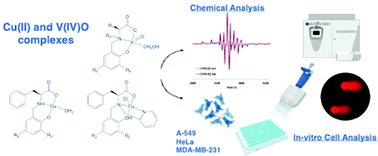Cu(ii) and V(iv)O complexes with tri- or tetradentate ligands based on (2-hydroxybenzyl)-l-alanines reveal promising anticancer therapeutic potential†
Abstract
Four new ligand precursors (H2L1–H2L4), derived from the Mannich condensation of two amino acids (L-Val and L-Phe) and two 3,5-disubstituted phenols (t-Bu or Me), and the corresponding oxidovanadium(IV) (1–4) and copper(II) (6–7) complexes are synthesized. Two other related compounds (H2L5 and H2L6), containing an additional 2-methyl-pyridine arm, and the corresponding VIVO (5) and CuII (8–9) complexes were also obtained. All metal complexes are monomeric in the solid state, having a solvent molecule or a chloride ion in the coordination sphere. The in vitro cytotoxic activity of all compounds is evaluated against cancer cells from different origins. The IC50 values at 72 h are in the range of 6–15 μM for HeLa cells, 4–17 μM for A-549 cells and >25 μM for MDA-MB-231 cells, except for [VIVOL1(CH3OH)] (1) and [CuL6(H2O)] (9). With the exception of H2L6, overall, the metal complexes are more cytotoxic than the corresponding ligand precursors. Globally, the cellular viability data show that (i) the L-Phe derived compounds are more cytotoxic than the corresponding L-Val complexes; (ii) the presence of the bulkier t-Bu groups increases the cytotoxicity; (iii) the presence of a 2-methyl-pyridine arm increases considerably the cytotoxicity; and (iv) the CuII-complexes are more cytotoxic than the VIVO-compounds. Complexes [VIVOL3(CH3OH)] (3), [CuL3(H2O)] (7) and [CuL5(H2O)] (8) were further evaluated and their mechanism of action was determined to be apoptosis, evidenced by AnnexinV staining and the increase in caspase 3/7 activity. Compounds 3, 7 and 8 also exhibit DNA cleavage activity, involving the formation of reactive oxygen species and were able to induce genomic damage in cells as determined by COMET assay.



 Please wait while we load your content...
Please wait while we load your content...